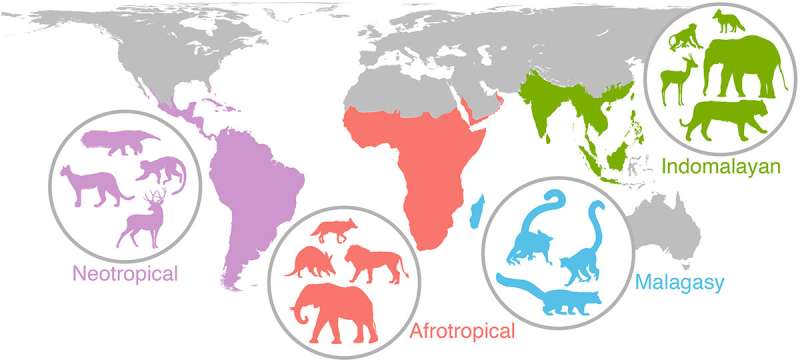Connecting the prehistoric past to the global future

Research on global biodiversity has long assumed that present-day biodiversity patterns reflect present-day factors, namely contemporary climate and human activities. A new study shows that climate changes and human impacts over the last 100,000 years continue to shape patterns of tropical and subtropical mammal biodiversity today—a surprising finding.
The new research—coauthored by Kaye E. Reed and Irene Smail, Arizona State University; Lydia Beaudrot, Rice University; Janet Franklin, University of California Riverside; and John Rowan, Andrew Zamora, and Jason M. Kamilar, University of Massachusetts Amherst—will be published in the Proceedings of the National Academy of Sciences.
Understanding the factors that structure global biodiversity patterns—the distribution and diversity of life on Earth—has been of long-standing scientific interest. To date, much of this research has focused on present-day climate, such as average temperature or rainfall, because climate is well-known to influence species geographic distributions and because human-caused climate change is a major threat. Likewise, other recent human impacts are well-known to influence biodiversity and are well-studied, such as deforestation and urbanization of wild lands that destroy habitats for many species.
What many of these studies overlook, however, is that present-day biodiversity patterns are the outcome of thousands of years of changes in Earth's climate and, more recently, prehistoric human activity. Thus, present-day biodiversity patterns need not be primarily driven by recent climate or human impacts. A small but growing body of studies suggest that legacies of the ancient past continue to structure patterns of life on Earth today. Indeed, though this may be the case, global-scale analyses on this issue remained elusive until now.
To tackle this issue, the researchers analyzed a database of 515 mammal communities across the globe. For each community (i.e., an assemblage of mammal species occupying the same area), they collected data on the species present, their ecological characteristics (body size, diet, etc.) and their evolutionary relationships to one another. They used this information to measure the ecological and evolutionary structure of each community and then asked whether it was best explained by present-day climate (current temperature and rainfall), Quaternary paleoclimate changes (changes in temperature and rainfall from around 22,000 years ago and 6,000 years ago to the present), recent human activity (land-use change since the Industrial Revolution) or prehistoric human activity (human-driven mammal extinctions that happened over the last 100,000 years as humans spread across the globe).
The research findings show, for the first time, that current patterns of mammal diversity across the world's tropical and subtropical regions are structured by both past and present climate and human impacts, but specific effects vary by region.
"We have long been interested in finding overarching explanations for what drives mammal diversity across the globe," said John Rowan. "For our research group, this study made us realize that there probably isn't one—every region of the world has its own distinct history, and that history matters today."
In the Neotropics (South and Central America), for example, mammal communities are strongly influenced by prehistoric human-driven extinctions over the last 100,000 years. When humans arrived in the Neotropics, they caused massive extinctions of the region's mammals, the effects of which linger today in the surviving communities. Conversely, Africa was lightly impacted by these extinctions, and the region's present-day communities are mainly shaped by current and prehistoric climates. Southeast Asia and Madagascar also have their own suite of past and present climatic and human factors that shape them.
These global differences highlight an important finding of the study—there is no one-size-fits-all explanation for what structures mammal biodiversity across the world. Each of world's major regions has a unique ecological and evolutionary history, and these histories continue to strongly influence the distribution and diversity of mammalian life on Earth.
"Now that we have a global study of the similarities and differences of the overarching effects on mammal communities," said Kaye Reed, "we will continue to explore each region in depth to examine other factors that affected these communities in the past and what that might mean for the future."
The climatic and human-impact legacies of the ancient past can be, and often are, as or more important than their present-day counterparts. As scientists continue to understand global patterns of biodiversity, the researchers suggest that past climate and human impact factors should be incorporated into future studies. They propose that this will result in a more holistic understanding of what drives biodiversity and how it may respond to ongoing and future human-caused changes in the 21st century.
More information: John Rowan el al., "Geographically divergent evolutionary and ecological legacies shape mammal biodiversity in the global tropics and subtropics," PNAS (2019). www.pnas.org/cgi/doi/10.1073/pnas.1910489116
Journal information: Proceedings of the National Academy of Sciences
Provided by Arizona State University




















